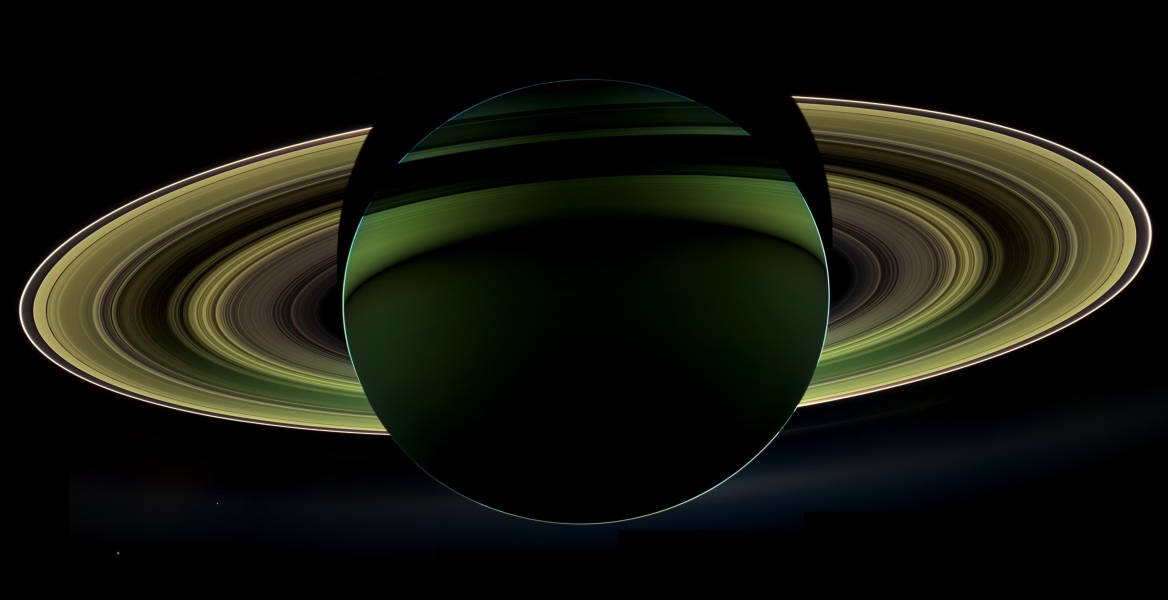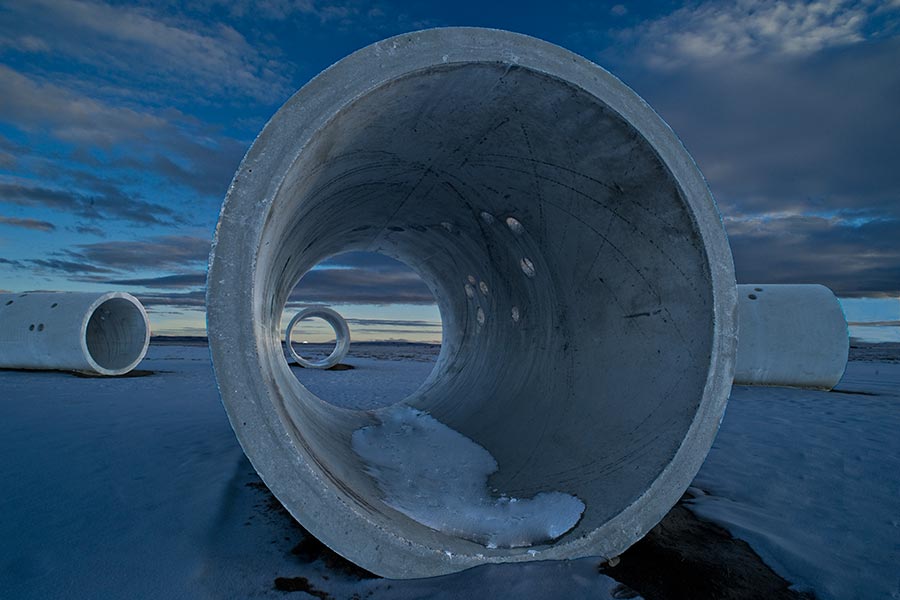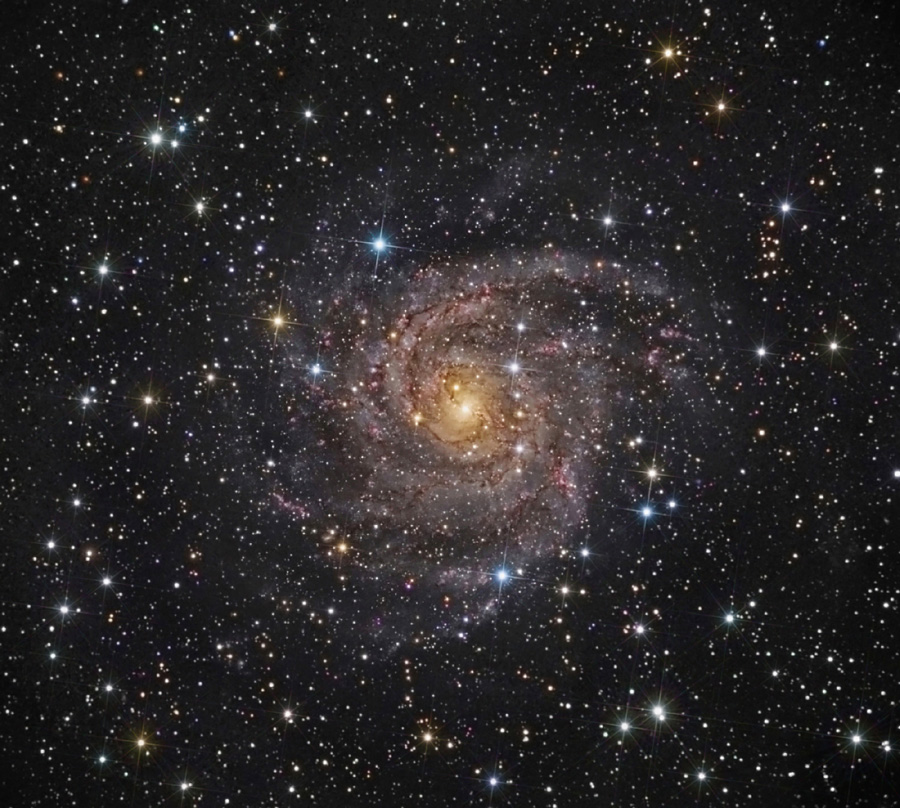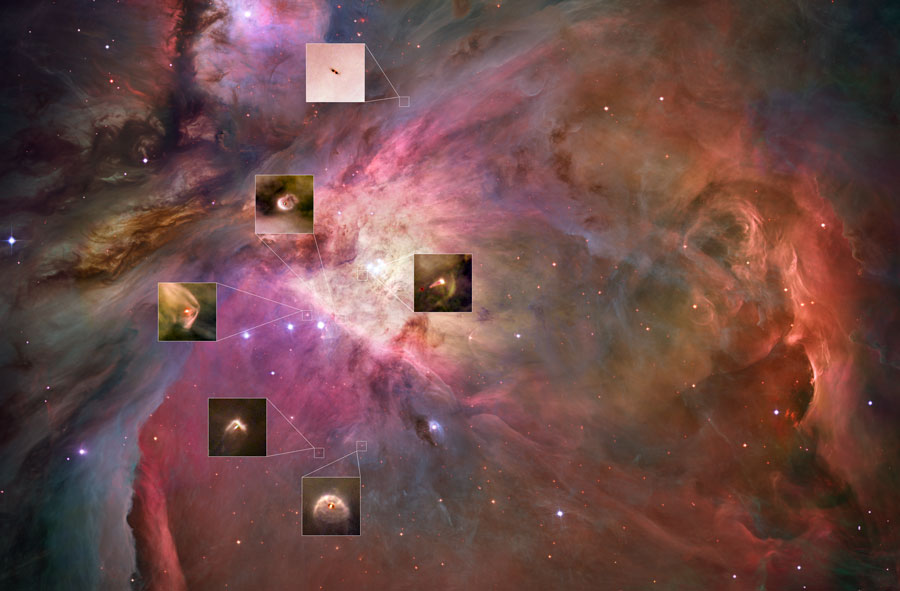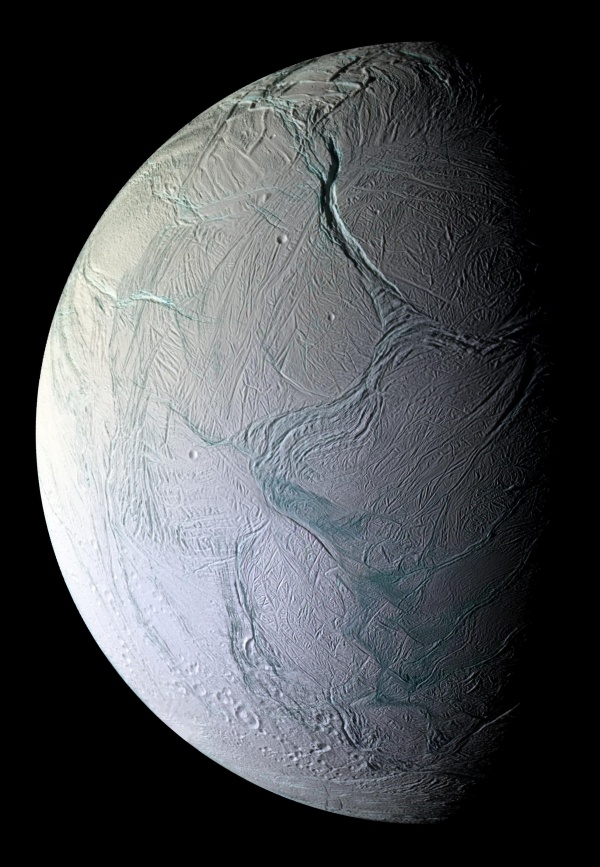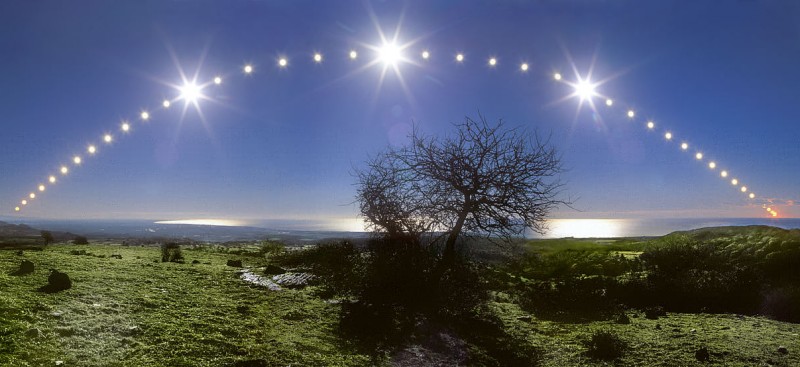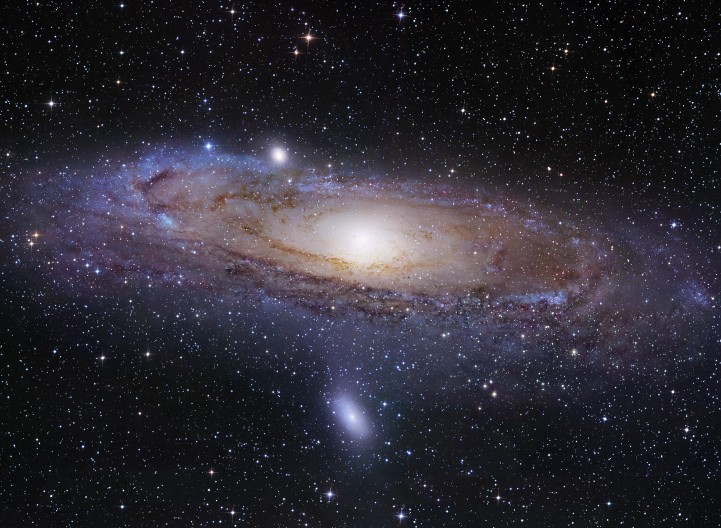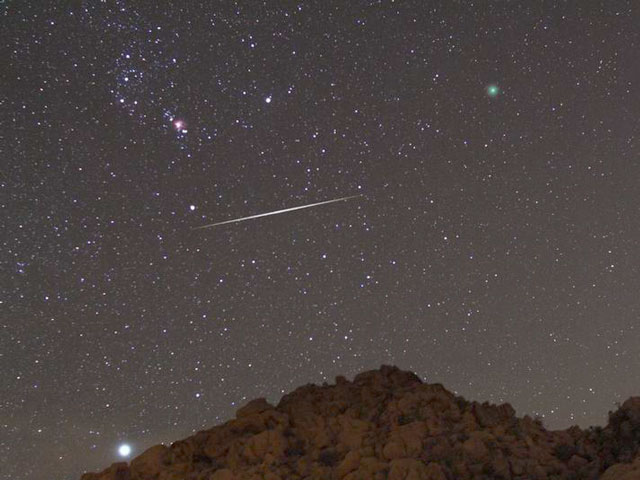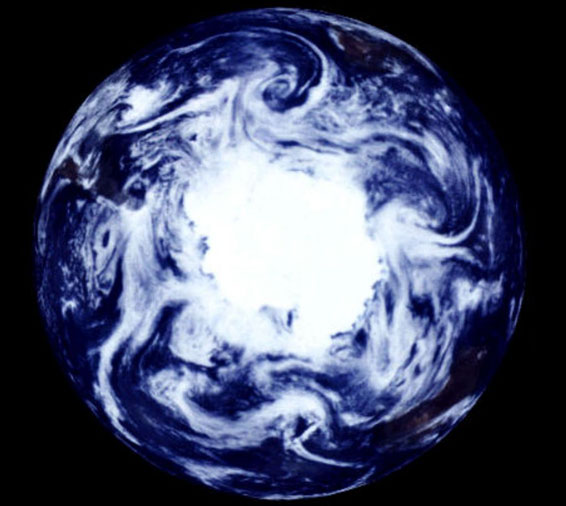| << Previous | Index | Next >> |
2014 What's creating methane on Mars? Recent measurements from the robotic Curiosity rover currently rolling across Mars indicate a surprising 10-fold increase in atmospheric methane between measurements only months apart. Life is a major producer of methane on Earth, and so speculation is rampant that some sort of life -- possibly microbial life -- is creating methane beneath the surface of Mars. Other possibilities do exist, though, with a leading model being the sudden release of methane produced by the mixing of specific soil chemicals with underground water. Proposed origins of Martian methane are depicted in the featured illustration. The origin of Mars' methane is a very active area of research, with missions like Curiosity and India's Mars Orbiter Mission searching for clues by measuring methane abundance changes and possible byproducts of different methane-producing processes.
2013 If you went outside at exactly the same time every day and took a picture that included the Sun, how would the Sun's position change? With great planning and effort, such a series of images can be taken. The figure-8 path the Sun follows over the course of a year is called an analemma. Yesterday, the Winter Solstice day in Earth's northern hemisphere, the Sun appeared at the bottom of the analemma. Analemmas created from different latitudes would appear at least slightly different, as well as analemmas created at a different time each day. With even greater planning and effort, the series can include a total eclipse of the Sun as one of the images. Pictured is such a total solar eclipse analemma or Tutulemma - a term coined by the photographers based on the Turkish word for eclipse. The above composite image sequence was recorded from Turkey starting in 2005. The base image for the sequence is from the total phase of a solar eclipse as viewed from Side, Turkey on 2006 March 29. Venus was also visible during totality, toward the lower right.
2012 Splendors seldom seen are revealed in this glorious picture from Saturn's shadow. Imaged by Cassini on October 17, 2012 during its 174th orbit, the ringed planet's night side is viewed from a perspective 19 degrees below the ring plane at a distance of about 800,000 kilometers with the Sun almost directly behind the planet. A 60 frame mosaic, images made with infrared, red, and violet filters were combined to create an enhanced, false-color view. Strongly backlit, the rings look bright away from the planet but dark in silhouette against the gas giant. Above center, they reflect a faint, eerie light on the cloud tops while Saturn casts its own dark shadow on the rings. A similar Cassini image from 2006 also featured planet Earth as a pale blue dot in the distance. Instead, this scene includes icy moons Enceladus (closer to the rings) and Tethys below the rings on the left.
2011 Today the Sun stands still at 05:30 UT. Halting its steady march toward southern declinations and begining its annual journey north, the event is known as a solstice. In the northern hemisphere December's solstice marks the astronomical start of winter. And if you're in the Great Basin Desert outside of Lucin, Utah, USA, near solstice dates you can watch the Sun rise and set through Sun Tunnels. A monumental earthwork by artist Nancy Holt, the Sun Tunnels are constructed of four 9 foot diameter cast concrete pipes each 18 feet long. The tunnels are arranged in a wide X to achieve the solstitial sunset and sunrise alignments. In this dramatic snapshot through a Sun Tunnel the Sun is just on the horizon. The cold, cloudy sunset was near the 2010 winter solstice. During daylight hours, holes in the sides of the pipes project spots of sunlight on their interior walls, forming a map of the principal stars in the constellations Draco, Perseus, Columba, and Capricorn. Fans of planet earthworks and celestial landart should note that the Sun Tunnels are about 150 miles by car from Robert Smithson's (Holt's late husband) Spiral Jetty.
2010 Similar in size to other large, bright spiral galaxies, IC 342 is a mere 7 million light-years distant in the long-necked, northern constellation Camelopardalis. A sprawling island universe, IC 342 would otherwise be a prominent galaxy in our night sky, but it is almost hidden from view behind the veil of stars, gas and dust clouds in the plane of our Milky Way galaxy. Even though IC 342's light is dimmed by intervening cosmic clouds, this remarkably sharp telescopic image traces the galaxy's own obscuring dust, blue star clusters, and glowing pink star forming regions along spiral arms that Wind far from the galaxy's core. IC 342 may have undergone a recent burst of star formation activity and is close enough to have gravitationally influenced the evolution of the local group of galaxies and the Milky Way.
2009 How do planets form? To help find out, the Hubble Space Telescope was tasked to take a detailed look at one of the more interesting of all astronomical nebulae, the Great Nebula in Orion. The Orion nebula, visible with the unaided eye near the belt in the constellation of Orion, is an immense nearby starbirth region and probably the most famous of all astronomical nebulas. Insets to the above mosaic show numerous proplyds, many of which are stellar nurseries likely harboring planetary systems in formation. Some proplyds glow as close disks surrounding bright stars light up, while other proplyds contain disks further from their host star, contain cooler dust, and hence appear as dark silhouettes against brighter gas. Studying this dust, in particular, is giving insight for how planets are forming. Many proplyd images also show arcs that are shock waves - fronts where fast moving material encounters slow moving gas. The Orion Nebula lies about 1,500 light years distant and is located in the same spiral arm of our Galaxy as our Sun.
2008 Do some surface features on Enceladus roll like a conveyor belt? A leading interpretation of recent images taken of Saturn's most explosive moon indicate that they do. This form of asymmetric tectonic activity, very unusual on Earth, likely holds clues to the internal structure of Enceladus, which may contain subsurface seas where life might be able to develop. Pictured above is a composite of 28 images taken by the robotic Cassini spacecraft in October just after swooping by the ice-spewing orb. Inspection of these images show clear tectonic displacements where large portions of the surface all appear to move all in one direction. Near the top of the image appears one of the most prominent tectonic divides: Labtayt Sulci, a canyon about one kilometer deep.
2007 Today the Solstice occurs at 0608 Universal Time, the Sun reaching its southernmost declination in planet Earth's sky. Of course, the December Solstice marks the beginning of winter in the northern hemisphere and summer in the south. When viewed from northern latitudes, the Sun will make its lowest arc through the sky along the southern horizon. So in the north, the Solstice day has the shortest length of time between sunrise and sunset and fewest hours of daylight. This striking composite image follows the Sun's path through the December Solstice day of 2005 in a beautiful blue sky, looking down the Tyrrhenian Sea coast from Santa Severa toward Fiumicino, Italy. The view covers about 115 degrees in 43 separate, well-planned exposures from sunrise to sunset.
2006 On December 22nd, at 0022 Universal Time the Sun reached its southernmost point in Earth's sky marking the final season change for the year 2006. In celebration of the Solstice, consider these images of the Sun from an extreme ultraviolet telescope onboard the Stereo Ahead spacecraft. Recorded on December 4th, Stereo's first day of imaging, each false-color view highlights atomic emission in different temperature regimes of the upper solar atmosphere; 2 million kelvins in yellow, 1.5 million in green, 1 million, in blue and 60 to 80 thousand in red. The Stereo Mission will place twin spacecraft, launched together in October, into different solar orbits to conduct a three dimensional exploration of the Sun and the solar environment. After completing lunar swingby maneuvers, the A spacecraft is intended to orbit the Sun "Ahead" of planet Earth, and the B spacecraft "Behind".
2005 The most distant object easily visible to the unaided eye is M31, the great Andromeda Galaxy some two million light-years away. But without a telescope, even this immense spiral galaxy - spanning over 200,000 light years - appears as a faint, nebulous cloud in the constellation Andromeda. In contrast, a bright yellow nucleus, dark winding dust lanes, gorgeous blue spiral arms and star clusters are recorded in this stunning telescopic digital mosaic with a cumulative exposure of over 90 hours. While even casual skygazers are now inspired by the knowledge that there are many distant galaxies like M31, astronomers seriously debated this fundamental concept only 80 years ago. Were these "spiral nebulae" simply outlying components of our own Milky Way Galaxy or were they instead "island universes" -- distant systems of stars comparable to the Milky Way itself? This question was central to the famous Shapley-Curtis debate of 1920, which was later resolved by observations of M31 in favor of Andromeda, island universe.
2004 Several wonders of the late-year northern sky appeared together for a few fleeting moments on December 13. On the bottom left, just above the hill, is blue Sirius, the brightest star in the sky. Above Sirius and slightly to the right of the belt of Orion is the red Orion Nebula, one of the most famous nebulas on the sky. Below and to the right of the Orion Nebula streaks a yellow meteor, although moving in the wrong direction to be from the Geminids meteor shower that peaked the night. Finally, above and to the right of the meteor is Comet Machholz, whose coma appears here relatively green. Since the time since this image was taken over a Californian hill, the Geminid meteor has long since evaporated. Comet Machholz has brightened and moved to the north. Sirius, however, will remain in the constellation of Canis Major indefinitely.
2003 Why does the Andromeda Galaxy have a giant ring? Viewed in ultraviolet light, the closest major galaxy to our Milky Way Galaxy looks more like a ring galaxy than a spiral. The ring is highlighted beautifully in this newly released image mosaic of Andromeda (M31) taken by the GALaxy Evolution Explorer (GALEX), a satellite launched into Earth orbit in April. In the above image, ultraviolet colors have been digitally shifted to the visual. Young blue stars dominate the image, indicating the star forming ring as well as other star forming regions even further from the galactic center. The origin of the huge 150,000-light year ring is unknown but likely related to gravitational interactions with small satellite galaxies that orbit near the galactic giant. M31 lies about three million light-years distant and is bright enough to be seen without binoculars toward the constellation of Andromeda.
2002 The December solstice brings the beginning of Winter to Earth's Northern Hemisphere and Summer time to the South! This view of Earth's Southern Hemisphere near the beginning of Summer was created using images from the Galileo spacecraft taken during its December 1990 flyby of our fair planet. Dramatically centered on the South Pole, this mosaic was constructed by piecing together images made over a 24 hour period so that the entire hemisphere appears to be in sunlight. South America (middle left), Africa (upper right), and Australia (lower right), are visible as dark masses while Antarctica gleams brightly in the center. Swirling clouds marking regularly spaced major weather systems are also prominent.
2001 Hot blue stars, red glowing hydrogen gas, and dark, obscuring dust clouds are strewn through this dramatic region of the Milky Way in the southern constellation of Ara (the Altar). About 4,000 light-years from Earth, the stars at the left are young, massive, and energetic. Their intense ultraviolet radiation is eating away at the nearby star forming cloud complex - ionizing the hydrogen gas and producing the characteristic red "hydrogen-alpha" glow. At right, visible within the dark dust nebula, is small cluster of newborn stars. This beautiful color picture is a composite of images made through blue, green, and hydrogen-alpha filters.
2000 Looking for that perfect holiday gift for an astronomer? Consider this "star in a box". Of course, the box is actually a computational box consisting of a three dimensional grid of points, and the star is a virtual one whose physical properties and internal dynamics are numerically simulated at the points on the grid. While computers and software capable of a totally realistic numerical simulation of a complete star don't presently exist, researchers have been making progress. This picture is a movie frame from a recent numerical simulation of a supergiant star with properties intended to approximate the real star Betelgeuse. The single frame shows large convection cells and bright spots mottling the virtual supergiant's surface. Simulation movies show these surface features changing substantially with time. Encouragingly, telescopic observations indicate that the surface of Betelgeuse does indeed have prominent large scale features and the well-known star's brightness variations are detectable with the unaided eye. The real supergiant Betelgeuse is some 2,500 degrees cooler than, and 620 times the size of the Sun.
1999 Tonight, those blessed with clear skies can enjoy a glorious full moon, the last full moon of the "Y1.9K"s. In fact, tonight's moon will be a full-perigee-solstice moon, reaching its full phase and perigee (the closest point in its orbit) on the solstice, the first day of northern hemisphere winter. Anticipation of this celestial event has generated a flood of e-mail chasing the rumor that the full-perigee-solstice moon will be intensely bright. However, calculations show it will only be a little brighter than usual, and certainly not dramatically so. Why would it be brighter? Mostly because the moon appears bigger and brighter at perigee. The above illustration, based on Galileo spacecraft images, shows the approximate difference in apparent size between a full moon at perigee (left) and a full moon at apogee, the farthest point in the lunar orbit. The Earth and moon are also a few percent closer to the sun during northern winter, but the combined effects will cause tonight's full moon to appear only about 20% brighter than an average full moon. That difference is not even likely to be noticeable to the human eye.
1998 Many of the 1998 Leonid shower meteors were so bright they could be seen even during sunrise. The above photograph was taken near the dawn of November 16 close to Hong Kong, China. However, most meteors are fainter and are not associated with any particular meteor shower. On any given night from a dark location it would not be unusual to see up to 10 meteors per hour, while the predictable Meteor showers might feature 100 meteors per hour. A true meteor storm will occur only a few times per century. The actual intensity of meteor storms is notoriously hard to predict, but may feature rates upwards of 10 meteors per second.
1997 David N. Schramm effectively combined the very big with the very small. Among his many scientific achievements, Schramm and collaborators successfully used Big Bang cosmology to predict that only three families of elementary particles exist in the universe, which was subsequently confirmed by high energy particle accelerators. Schramm and collaborators realized that current relative elemental abundance measurements, when combined with nuclear reaction rates, constrain the amount of normal matter to be much less than that implied by the movements of stars and galaxies. Therefore, most of the universe might be made of some sort of dark matter. Schramm was a champion wrestler, a mountain climber, an inspiration to scientists and students, and was alone piloting a plane when it crashed last Friday.
1996 Diminutive Deimos is the smallest of the two tiny Moons of Mars. Potato shaped and barely 6 miles wide this asteroid-like body was visited by the Viking 2 orbiter in 1977. This image was made when the spacecraft approached to within 18 miles of Deimos' surface. It is one of the most detailed pictures of a celestial body ever taken by an orbiting spacecraft - the field of view is less than a square mile and features just under 10 feet across are visible. Craters and large chunks of rock are seen scattered on the surface. Some of the craters appear to have been covered by a layer of regolith (soil and broken rock).
1995 December 22 marks the Winter Solstice - the beginning of winter in the Earth's northern hemisphere, and the first day of summer in the south! This view of Earth's southern hemisphere near the beginning of its summer was created using images from the Galileo spacecraft taken during the December 1990 flyby. Dramatically centered on the South Pole, this mosaic was constructed by piecing together images made over a 24 hour period so that the surface appears to be entirely in sunlight. South America (middle left), Africa (upper right), and Australia (lower right), are visible as dark masses while Antarctica gleams brightly in the center. Swirling clouds marking the major weather systems are also prominent.
| << Previous | Index | Next >> |


